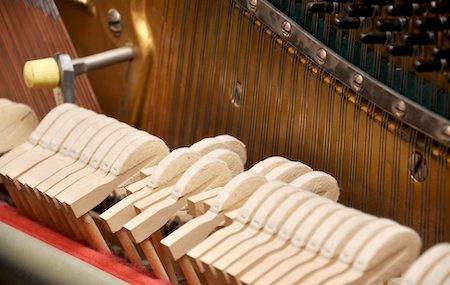A piano hammer is the part of the action that strikes the strings when a key is pressed. Hammers are responsible for producing sound as you push down on each key.
They are manufactured with a thick, stiff felt stretched around wooden molding using tension. This tension creates a “bounce” factor that causes the hammer to “bounce” off the string after it strikes it, creating a specific vibration or tone.
As one of the most moveable action items in a piano, it should be no surprise to learn how durable this mechanism is. Over time, the piano’s strings tamp down on the felt, breaking down the fibers with each repeated strike. This impacts the piano’s sound. When you press a key without a clean blow, it strikes without intensity, generating a harsh sound that isn’t pleasing to the ear.
Once you notice this, it’s time for the piano hammer to be replaced.
Is this something you’ll have to do often? It depends. A concert piano that is used regularly for performances will undergo much more maintenance and care than a piano used periodically in a home environment.
Playing is one factor, but it isn’t the only one. Location matters – is the piano in harsh conditions with direct sunlight, changing temperatures, and lots of humidity? That can wear down the felt quickly too.
There isn’t a specific lifespan for when you’ll replace piano hammers. Instead, it’s important to watch for signs of change, guiding you to make repairs long before they wear down and need total replacement.
Piano hammers have a characteristic egg shape. As they connect with the strings and begin to harden into grooves, a professional is able to reshape the hammers back to their original condition. Most piano hammers can be reshaped up to three times before the shape and hardness require repair. This restoration process involves using fine sandpaper to return it to the required shape.
How do you know when it’s time?
The first step is with an audible clue. When hammers are worn down, the piano will create a harsh and unpleasant sound. The tone will be different from what you’re accustomed to.
The second is by looking at the hammers. If the grooves in the felt are half the diameter of the strings themselves, then the hammers require reshaping at a minimum. As the tracks move closer to the same width as the strings, then the hammers will require replacement.
Do all pianos need to have hammers replaced? Yes, eventually. This is where the action happens, where sound is created, and where the most stress is created.
Regular maintenance will ensure its quality to keep your piano in good working condition. That includes replacement of items like the piano hammers from time to time. It’ll keep your piano playable.


